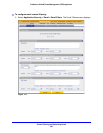
Content Filtering and Optimizing Scans
203
ProSecure Unified Threat Management (UTM) Appliance
This order of implementation ensures the optimum balance between spam prevention and
system performance. For example, if an email originates from a whitelisted source, the UTM
delivers the email immediately to its destination inbox without implementing the other
spam-prevention technologies, thereby speeding up mail delivery and conserving the UTM
system resources. However, regardless of whether an email is whitelisted, the email is still
scanned by the UTM’s antimalware engines.
You can configure these antispam options in conjunction with content filtering to optimize
blocking of unwanted mails.
Note: Emails that are processed through the UTM over an authenticated
email connection between a client and a mail server are not checked
for spam.
Note: An email that has been checked for spam by the UTM contains an
X-STM-SMTP (for SMTP emails) or X-STM-POP3 (for POP-3
emails) tag in its header.
Set Up the Whitelist and Blacklist
You can specify that emails are accepted or blocked based on the originating IP address,
domain, and email address by setting up the whitelist and blacklist. You can also specify that
emails are accepted based on the destination domain and email address.
The whitelist ensures that emails from listed (that is, trusted) sources and recipients are not
mistakenly tagged as spam. Emails going to and from these sources and recipients are
delivered to their destinations immediately, without being scanned by the antispam engines.
This can help to speed up the system and network performance. The blacklist, on the other
hand, lists sources from which all email messages are blocked. You can enter up to 200
entries per list, separated by commas.
Note: The whitelist takes precedence over the blacklist, which means that
if an email source is on both the blacklist and the whitelist, the email
is not scanned by the antispam engines.


















